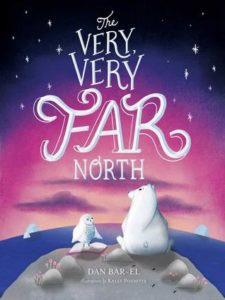
The Very, Very Far North
Dan Bar-El
Atheneum
Published September 3, 2019
Amazon | Barnes & Noble | Book Depository | Goodreads
About The Very, Very Far North
An inquisitive polar bear named Duane befriends an array of animals as he discovers where he belongs in this charming classic-in-the making that’s reminiscent of Winnie the Pooh.
In the Very, Very Far North, past the Cold, Cold Ocean and just below the hill that looks like a baby whale, you’ll find Duane and his friends.
Duane is a sweet and curious young bear who makes friends with everyone he meets—whether they’re bossy, like Major Puff the puffin, or a bit vain, like Handsome the musk ox, or very, very shy, like Boo the caribou. For these arctic friends, every day is a new adventure!
My Review
I love how whimsical THE VERY, VERY FAR NORTH is. It’s kind of a collection of short stories all about Duane and the friends he meets in the Very, Very Far North. His friends have very different personalities, which means Duane has to pay attention and learn to relate to his friends based on their needs and his own comfort and boundaries.
I think this would be a great book to read with a younger reader as a way to have conversations about relationships and boundaries. Duane’s experiences happen naturally in the story, but the events definitely open a door to talk about what it means to be friends with someone with different needs than ours. I liked that.
THE VERY, VERY FAR NORTH is a simple, fun read. The characters are all very different from one another and bring a lot of humor and heart to the story. Recommended especially for fans of A. F. Harrold.
Content Notes
Recommended for Ages 8 to 12.
Representation
Most characters are animals. Two minor characters are humans.
Profanity/Crude Language Content
None.
Romance/Sexual Content
None.
Spiritual Content
None.
Violent Content
Major Puff is prepared to fight his enemy, the black-backed gull, if ever he should meet one.
Drug Content
None.
Note: This post contains affiliate links, which do not cost you anything to use, but which help support the costs of running this blog. I received a free copy of THE VERY, VERY FAR NORTH in exchange for my honest review.
About Dan Bar-El
Dan Bar-el is an award-winning children’s author, educator, and storyteller whose books include Audrey (cow), Not Your Typical Dragon, and The Very, Very Far North. Dan has worked with children ages three to thirteen as a school-age childcare provider, a preschool teacher, a creative drama teacher, and a creative writing teacher. He also teaches with the Creative Writing for Children Society. Dan lives in Vancouver, British Columbia, with artist and goldsmith Dominique Bréchault, and Sasha, the most adorable cat in the known universe. Visit him at DanBarel.com.
Follow the Blog Tour
September 2 – The Story Sanctuary – you are here!
September 3 – Kirsti Call
September 4 – Randomly Reading
September 5 – Alexa Loves Books
September 6 – Jean Little Library
September 7 – Tale Out Loud
September 8 – Satisfaction for Insatiable Readers
September 9 – Insane About Books